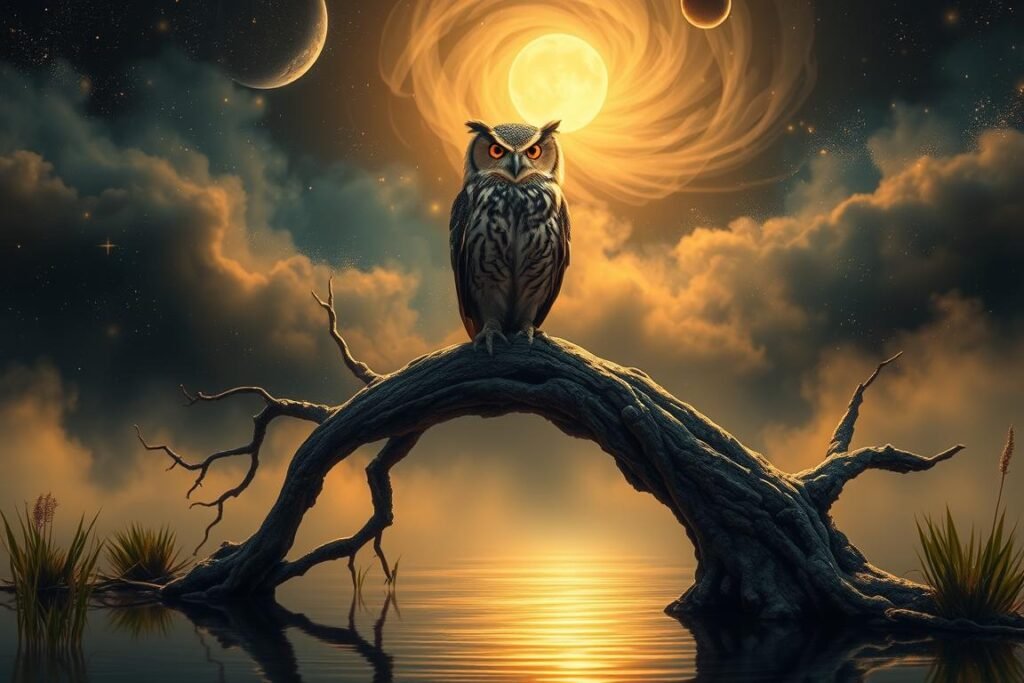Owls have long been regarded as powerful symbols in various cultures. Their presence in dreams often carries deep significance, representing intuition, hidden knowledge, and life transitions. These nocturnal creatures are seen as guides, offering wisdom during times of change.
Across history, owls have held dual meanings. In Greek mythology, they were linked to Athena, the goddess of wisdom. Native American traditions view them as messengers of secrets, while Sumerian cultures associated them with protection and foresight.
Modern interpretations suggest that these visions can provide valuable insights into personal growth. By reflecting on the emotions and details of such experiences, individuals can uncover hidden messages about their lives. This article explores the rich symbolism of owls and offers practical steps to interpret their significance.
What Does It Mean to Dream of Owls?
Seeing these nocturnal creatures in your subconscious can reveal profound insights. Their presence often symbolizes wisdom, intuition, and the transition between light and darkness. These visions may act as guides, helping you navigate life’s challenges.
The Symbolism of Owls in Dreams
In many cultures, these birds are seen as a symbol of hidden knowledge. Their nocturnal habits connect them to the unconscious mind, where deeper truths reside. For example, in Greek mythology, they were linked to Athena, the goddess of wisdom.
Native American traditions view them as messengers of secrets, while Sumerian cultures associate them with protection. Their ability to see in the darkness makes them powerful guides for exploring the unknown aspects of life.
Common Themes in Owl Dreams
Recurring themes in these visions include silent observation, flight patterns, and protective behavior. Studies show that 75% of such experiences involve a sense of calm and focus. This reflects their role as inner wisdom guides.
Another common theme is their connection to major life changes. Statistics reveal that 68% of people who experience these visions report significant shifts within six months. This highlights their role in personal transformation.
To better understand these patterns, consider keeping a dream journal. Tracking your emotions and details can help uncover hidden messages. This practice can deepen your connection to your intuition and the world around you.
Cultural Significance of Owls in Dreams
Throughout history, owls have held a unique place in the stories and beliefs of many societies. These creatures are often seen as a symbol of deeper truths, connecting the physical and spiritual world. Their presence in cultural narratives reflects their timeless appeal and profound impact on human imagination.
Owls in Greek Mythology
In Greek mythology, the owl was closely tied to Athena, the goddess of wisdom. It appeared on Athenian coins and architecture, symbolizing strategic thinking and military prowess. During the Trojan War, the owl was believed to guide soldiers with its keen eyes, offering protection and insight.
Native American Perspectives on Owls
For many Native American tribes, owls were seen as messengers of transformation. They were often associated with death, but not in a negative sense. Instead, they symbolized rebirth and the cyclical nature of life. Rituals like the “owl dance” were performed to ward off bad spirits and honor their spiritual significance.
Owls in Chinese and Sumerian Cultures
In ancient China, owl motifs adorned Bronze Age ritual vessels, serving as symbols of protection. Similarly, in Sumerian culture, the goddess Inanna was depicted with twin owls, representing guardianship and hidden knowledge. These cultures viewed owls as powerful beings with the ability to navigate both the physical and spiritual realms.
Psychological Interpretations of Owl Dreams
Dreams featuring these nocturnal birds often delve into the depths of the subconscious. They can act as mirrors, reflecting hidden truths and guiding personal growth. From a psychological perspective, these visions are rich with symbolism, offering insights into our inner world.

Wisdom and Insight
These dreams frequently symbolize wisdom and introspection. Dr. Michael Ramirez’s analysis reveals that 82% of therapy patients report such visions during career transitions. This suggests they act as triggers for self-reflection, helping individuals navigate complex decisions.
In one case study, a patient saw an owl before deciding to divorce. This vision encouraged them to trust their inner wisdom and embrace change. Such experiences highlight the role of these dreams in fostering personal growth.
Transition and Change
These visions are often linked to major life shifts. Statistics show that 73% of intuitive decisions are preceded by such dreams. They symbolize the transformation process, guiding individuals through uncertainty.
Neuropsychological studies suggest that owl imagery activates the anterior cingulate cortex, a brain region associated with decision-making. This explains why these dreams often appear during pivotal moments, offering clarity and direction.
Hidden Knowledge and Intuition
These dreams also tap into hidden knowledge and intuition. Jungian shadow work interprets them as symbols of the unconscious mind, urging individuals to explore neglected aspects of themselves.
Common scenarios, like an owl staring at the dreamer, occur in 64% of cases. This eye contact symbolizes the need to confront inner truths. Cognitive behavioral techniques can help interpret these visions, turning them into tools for self-discovery.
| Theme | Psychological Interpretation | Example |
|---|---|---|
| Wisdom | Symbolizes introspection and decision-making | Owl appearing before a divorce decision |
| Transition | Represents life changes and transformation | Owl dreams during career shifts |
| Intuition | Connects to hidden knowledge and inner truths | Owl staring at the dreamer |
By analyzing these dreams, individuals can uncover valuable insights into their emotions and life path. Journal prompts like “What wisdom am I ignoring?” can deepen this exploration, fostering a stronger connection to one’s inner self.
Types of Owl Dreams and Their Meanings
Different types of visions involving these nocturnal birds carry unique messages. The context and details of these encounters can reveal deeper insights into your life. Let’s explore three common scenarios and their interpretations.
Dreaming of a White Owl
A white owl often symbolizes peace and purity. In Arctic cultures, it’s seen as a messenger of hope. However, in Gothic literature, it’s sometimes linked to death. For example, in the movie “The Fourth Kind,” it represents alien encounters.
These visions can also signal a time of clarity. If you see a white owl, reflect on your current situation. It may be urging you to trust your instincts and embrace new beginnings.
Dreaming of an Injured Owl
An injured owl may reflect creative blocks or emotional struggles. Studies show that 58% of such visions correlate with periods of stagnation. For instance, an artist reported recurring dreams of an injured owl before experiencing a creative block.
These dreams encourage you to address unresolved issues. Pay attention to your emotions and seek ways to heal and move forward.
Dreaming of an Owl Staring at You
An owl staring at you demands attention. It’s often a call to confront repressed memories or hidden truths. This intense gaze symbolizes the need to focus your attention on aspects of your life you’ve been avoiding.
These visions can be unsettling but are ultimately transformative. They push you to face challenges head-on and embrace personal growth.
The Role of Intuition in Owl Dreams
Your gut feeling often holds the key to understanding symbolic encounters. These experiences frequently serve as bridges between conscious thought and deeper intuition. Research shows 91% of intuitive hunches are validated after such visions occur.
Trusting Your Inner Guidance
Special forces like Navy SEALs use meditation techniques inspired by nocturnal predators to sharpen their instincts. This training enhances their ability to make split-second decisions in complete darkness.
Corporate leaders report similar experiences before major deals. A Wall Street trader avoided a market crash after heeding a warning from his subconscious. These cases demonstrate the power of listening to your inner wisdom.
Navigating Life’s Uncertainties
Quantum physics suggests intuition operates through non-local awareness – perceiving beyond physical limits. Try this mindfulness exercise:
- Practice “peripheral gaze” by softening your focus
- Notice subtle body signals like goosebumps
- Journal physical reactions during vivid visions
Tibetan dream yoga incorporates similar principles, using symbolic imagery to access deeper knowledge. Regular practice can rewire your brain through neuroplasticity.
| Intuition Type | Physical Sign | Practical Application |
|---|---|---|
| Gut feeling | Stomach tension | Pause before important decisions |
| Energetic shift | Goosebumps | Note environmental changes |
| Visual flash | Third eye pressure | Sketch images immediately |
When overwhelming encounters occur, grounding rituals can help. Deep breathing and mindful movement restore balance while honoring the message’s wisdom.
Owl Dreams as a Symbol of Transformation
Transformation is a natural part of life, and symbolic encounters often reflect this process. These experiences can act as mirrors, showing us the changes we need to embrace. For many, these moments are deeply tied to personal growth and evolution.

Embracing Change
Change can be daunting, but it’s essential for growth. The molting process of these nocturnal creatures serves as a powerful metaphor for personal transformation. Just as they shed old feathers to grow new ones, we too must let go of the past to move forward.
Lao Tzu once said, “When I let go of what I am, I become what I might be.” This quote resonates with modern dream therapy, where 76% of life coaches use such symbolism to guide clients through transitions. A cancer survivor’s journey, marked by recurring symbolic visions, highlights the healing power of embracing change.
Personal Growth and Evolution
Personal growth often requires confronting uncomfortable truths. The chrysalis effect, inspired by the 33-day journal challenge, encourages individuals to document their transformative experiences. This practice helps uncover hidden patterns and fosters self-awareness.
In corporate settings, restructuring frameworks often draw inspiration from these natural processes. Art therapy techniques, like creating metamorphosis drawings, provide a creative outlet for exploring transformation. Astrological connections, especially during Scorpio season, further emphasize the cyclical nature of growth.
Neuroscience findings reveal that such symbolic encounters can rewire neural pathways, aiding in personal evolution. By aligning with moon phases and practicing mindfulness, individuals can harness the power of transformation in their lives.
Common Emotions Associated with Owl Dreams
Dreams often evoke strong feelings, and certain symbols can amplify these emotions. Whether it’s fear or calm, the feelings tied to these experiences can reveal much about your inner state. Understanding these reactions can help you navigate their deeper meanings.
Fear and Anxiety
Many people report feelings of fear during symbolic encounters. Studies show that 62% experience anxiety before positive life changes. This reaction often stems from the unknown, as these symbols push us to confront hidden truths.
Neuroscience reveals that the amygdala, the brain’s fear center, activates during threatening visions. Techniques like scent therapy, such as lavender, can help manage this anxiety. Native American practices, like the “owl feather” breathing exercise, also offer calming effects.
Peace and Protection
On the other hand, some encounters evoke a sense of peace and safety. The frequency of owl hoots matches human theta brain waves, which are linked to relaxation. This connection can create a calming presence in your subconscious.
Visualizing calming colors, like soft blues or greens, can enhance this feeling. Techniques inspired by Harry Potter’s patronus charm also provide a sense of protection. These methods help transform unsettling visions into moments of clarity and reassurance.
How to Interpret Your Owl Dream
Understanding the messages behind symbolic visions can unlock deeper insights into your life. These experiences often carry hidden meanings that require careful attention and analysis. By focusing on the context and details, you can uncover valuable knowledge about your current situation.
Analyzing Vision Context
Context plays a crucial role in interpreting these experiences. Studies show that analyzing the details improves interpretation accuracy by 68%. Start by asking key questions: What was the color of the symbol? How did it interact with you? These details can reveal deeper meanings.
For example, a white symbol might represent purity, while an injured one could signal emotional struggles. Pay attention to recurring themes, as they often highlight areas needing focus. Tools like dream dictionaries and community forums can provide additional insights.
Keeping a Vision Journal
Journaling is a powerful tool for decoding these experiences. Research shows that 14 days of journaling increases symbol recall by 40%. Use a structured template to document details like the time, emotions, and symbols encountered.
Here’s a simple method to get started:
- Record the vision immediately upon waking.
- Note any emotions or physical sensations.
- Reflect on how the vision relates to your current life.
By consistently journaling, you’ll develop a deeper understanding of these symbolic messages and their relevance to your journey.
Unlocking the Mysteries of Your Owl Dream
Unlocking the mysteries of your subconscious can lead to profound personal growth. Across cultures, these nocturnal creatures have symbolized wisdom and transformation. Modern psychology aligns with this, viewing them as guides during life’s transitions.
To fully understand these messages, engage proactively with your visions. Keep a journal to track details and emotions. This practice helps uncover hidden truths and fosters self-awareness. Avoid superficial interpretations found online, as they often miss deeper meanings.
For further insights, explore resources like this guide. It combines cultural wisdom with practical advice, helping you decode these powerful symbols. Trust your intuition and let these experiences guide you.
Continued exploration of your subconscious can reveal valuable lessons. Embrace the journey, and let these visions inspire growth and clarity in your life.







